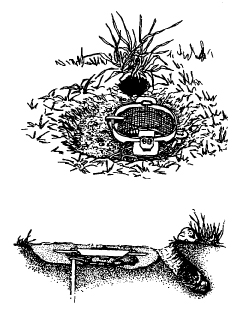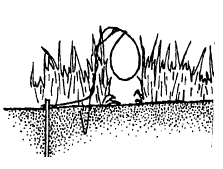|
Foxes | Fox Overview | Fox Damage Assessment | Fox Damage Management | Foxes Acknowledgements | Foxes Resources | ICWDM | Wildlife Species Information |
Damage Prevention and Control Methods
Exclusion

Construct net wire fences with openings of 3 inches (8 cm) or less to exclude red foxes. Bury the bottom of the fence 1 to 2 feet (0.3 m to 0.9 m) with an apron of net wire extending at least 12 inches (30 cm) outward from the bottom. A top or roof of net wire may also be necessary to exclude all foxes, since some will readily climb a fence.
A 3-wire electric fence with wires spaced 6 inches, 12 inches, and 18 inches (15 cm, 31 cm, and 46 cm) above the ground can repel red foxes. Combination fences that incorporate net and electric wires are also effective.
Cultural Methods
The protection of livestock and poultry from fox depredation is most important during the spring denning period when adults are actively acquiring prey for their young. Watch for signs of depredation during the spring, especially if there is a history of fox depredation. Foxes, like other wild canids, will often return to established denning areas year after year. Foxes frequently den in close proximity to human habitation. Dens may be located close to farm buildings, under haystacks or patches of cover, or even inside hog lots or small pastures used for lambing. Because of the elusive habits of foxes, dens in these locations may not be noticed until excessive depredations have occurred.
The practice of shed lambing and farrowing in protected enclosures can be useful in preventing fox depredation on young livestock. Also, removal of livestock carcasses from production areas can make these areas less attractive to predators.
Frightening
Foxes readily adapt to noise-making devices such as propane exploders, timed tape recordings, amplifiers, or radios, but such devices may temporarily reduce activity in an area.
Flashing lights, such as a rotating beacon or strobe light, may also provide temporary protection in relatively small areas or in livestock or poultry enclosures. Combinations of frightening devices used at irregular intervals should provide better protection than use of a single device because animals may have more difficulty in adapting to these disturbances.
When properly trained, some breeds of dog, such as Great Pyrenees and Akbash dogs, have been useful in preventing predation on sheep. The effectiveness of dogs, even the “guard dog” breeds, seems to depend entirely on training and the individual disposition of the dog.
Toxicants
The M-44®, a sodium cyanide mechanical ejection device, is registered for control of red and gray foxes by USDA-APHIS-Wildlife Services personnel in some states. Information on the safe, effective use of sodium cyanide is available from the appropriate state agency charged with the registration of pesticides. M-44s are generally set along trails and at crossings regularly used by foxes.
Fumigants
Gas cartridges made by USDA-APHIS-Wildlife Services are registered for fumigating the dens of coyotes, pocket gophers, ground squirrels, and other burrowing rodents. Special Local Needs permits 24(c) are available in North and South Dakota and Nebraska for gas cartridge fumigation of fox dens. State and local regulations should be consulted before using den fumigants.
Trapping
Trapping is a very effective and selective control method. A great deal of expertise is required to effectively trap foxes. Trapping by inexperienced people may serve to educate foxes, making them very difficult to catch, even by experienced trappers. Traps suitable for foxes are the Nos. 1 1/2, 1 3/4, and 2 double coilspring trap and the Nos. 2 and 3 double longspring trap. Traps with offset and padded jaws cause less injury to confined animals and facilitate the release of nontarget captures. State and provincial wildlife agencies regulate the traps and sets that can be used for trapping. Consult your local agency personnel for restrictions that pertain to your area.
Figure 5. Good locations for setting leghold traps for foxes. Figure 6. A dirt-hole set showing proper trap placement.


Proper set location is important when trapping foxes. Sets made along trails, at entrances to fields, and near carcasses are often most productive (Fig. 5). Many different sets are successful, and can minimize the risk of nontarget captures. One of the best is the dirt-hole set (Fig. 6). Dig a hole about 6 inches (15 cm) deep and 3 inches (8 cm) in diameter at a downward angle just behind the spot where the trap is to be placed. Four to five drops of scent should be placed in the back of the hole. Move back from the bait hole and dig a hole 2 inches (5 cm) deep that is large enough to accommodate the trap and chain. Fasten the trap chain to a trap stake with a chain swivel and drive the stake directly under the place where the trap is set. Fold and place the chain under or beside the trap. Set the trap about 1/2 inch (1.3 cm) below the ground. Adjust the tension device on the trap to eliminate the capture of lighter animals. When the set is completed, the pan of the trap should be approximately 5 inches (13 cm) from the entrance of the hole with the pan slightly offset from the center of the hole (Fig. 6). Cover the area between the jaws and over the trap pan with a piece of waxed paper, light canvas, or light screen wire. The trap must be firmly placed so that it does not move or wobble. The entire trap should be covered lightly with sifted soil up to the original ground level.
Fox scents and lures can be home-made, but this requires some knowledge of scent making as described in various trapping books. Commercial trap scents can be purchased from most trapping suppliers (see [WDM Supplies And Materials]). Experiment with various baits and scents to discover the combination of odors that will be most appropriate for your area.
Equipment needed for trapping foxes includes traps, a sifter with a 3/16- or 1/2-inch screen (0.5 or 1.3 cm), trap stakes, trowel, gloves (which should be used only for trapping), a 16- to 20-ounce (448- to 560-g) carpenter’s hammer with straight claws, and a bottle of scent. Remove the factory oil finish on the traps by boiling the traps in water and vinegar or by burying the traps in moist soil for one to two weeks until lightly rusted. The traps should then be dyed with commercially available trap dye to prevent further corrosion. Do not allow the traps and other trapping equipment to come in contact with gasoline, oil, or other strong-smelling and contaminating materials. Cleanliness of equipment is absolutely necessary for consistent trapping success.
Cage traps are sometimes effective for capturing juvenile red foxes living in urban areas. It is uncommon to trap an adult red fox in a cage or a box trap; however, kit and swift foxes can be readily captured using this method.

Snares made from 1/16-inch, 5/64-inch, and 3/32-inch (0.15 cm, 0.2 cm, and 0.25 cm) cable can be very effective for capturing both red and gray foxes. Snares are generally set in trails or in crawl holes (under fences) that are frequented by foxes. The standard loop size for foxes is about 6 inches (15 cm) with the bottom of the loop about 10 to 12 inches (25 to 30 cm) above ground level (Fig. 7). Trails leading to and from den sites, and to carcasses being fed on by foxes, make excellent locations for snares.
Shooting
Harvest of foxes by sport hunters and fur trappers is another method of reducing fox populations in areas where damage is occurring. Livestock and poultry producers who have predation problems during the late fall and winter can sometimes find private fur trappers willing to hunt or trap foxes around loss sites. Depredations are usually most severe, however, during the spring when furs are not saleable, and it is difficult to interest private trappers at that time.
Artificial rabbit distress calls can be used to decoy foxes to within rifle or shotgun range. Select a spot that faces into the wind, at the edge of a clearing or under a bush on a slight rise where visibility is good. Blow the call at 1/2- to 1-minute intervals, with each call lasting 5 to 10 seconds. If a fox appears, remain motionless and do not move the rifle or shotgun until ready to shoot. If a fox does not appear in about 20 minutes, move to a new spot and call again.
Aerial hunting can be used in some western states to remove problem foxes. This activity is closely regulated and is usually limited to USDA-APHIS-Wildlife Services personnel or individuals with special permits from the state regulatory agency.
Den Hunting
Fox depredations often increase during the spring whelping season. Damage may be reduced or even eliminated by locating and removing the young foxes from the den. Locate fox dens by observing signs of fox activity and by careful observation during the early and late hours of the day when adult foxes are moving about in search of food. Preferred denning sites are usually on a low rise facing a southerly direction. When fox pups are several weeks old, they will spend time outside the den in the early morning and evening hours. They leave abundant signs of their presence, such as matted vegetation and remnants of food, including bits of bone, feathers, and hair. Frequently used den sites have a distinctive odor.
Fox pups may be removed by trapping or by fumigating the den with gas cartridges if they are registered for your area. In some situations it may be desirable to remove the pups without killing them. The mechanical wire ferret has proved to be effective in chasing the pups from the den without harming them. This device consists of a long piece of smooth spring steel wire with a spring and wooden plug at one end and a handle at the other. This wire is twisted through the den passage ways, chasing foxes out of other den openings where they can be captured by hand or with dip nets. Small dogs are sometimes trained to retrieve pups unharmed from dens. Wire-cage box traps placed in the entrance of the den can also be useful for capturing young foxes.
Summary of Damage Prevention and Control Methods
Exclusion
Net wire fence. Electric fence.
Cultural Methods
Protect livestock and poultry during most vulnerable periods (for example, shed lambing, farrowing pigs in protective enclosures).
Frightening
Flashing lights and exploders may provide temporary protection.
Well-trained livestock guarding dogs may be effective in some situations.
Repellents
None are registered for livestock protection.
Toxicants
M-44® sodium cyanide mechanical ejection device, in states where registered.
Fumigants
Gas cartridges for den fumigation, where registered.
Trapping
Steel leg hold traps. Cage or box traps. Snares.
Shooting
Predator calling techniques. Aerial hunting.
Other Methods
Den hunting. Remove young foxes from dens to reduce predation by adults
|
Foxes | Fox Overview | Fox Damage Assessment | Fox Damage Management | Foxes Acknowledgements | Foxes Resources | ICWDM | Wildlife Species Information |
